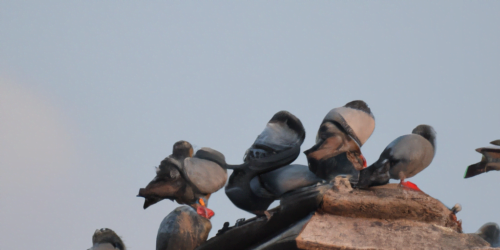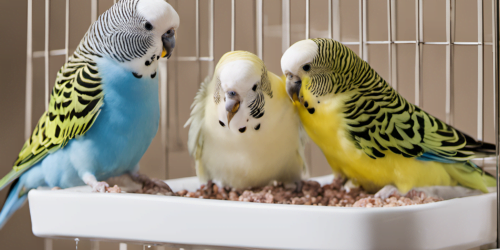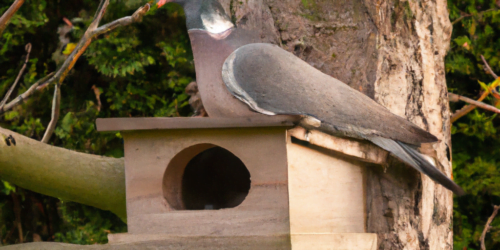Why Do Birds Migrate: The Fascinating Journey

Introduction – Why do Birds Migrate?
Table Of Contents
Why do birds migrate? It’s a question that has long puzzled scientists and nature enthusiasts alike.
As we witness the awe-inspiring sight of flocks of birds soaring through the sky, we can’t help but wonder what compels them to embark on these remarkable journeys year after year.
The urge to travel seems almost innate in these winged creatures, driven by a combination of instinct and necessity.
Over millions of years, bird migration has evolved as a survival strategy, with some species genetically programmed to undertake these arduous voyages.
Nature provides subtle cues that trigger migratory behaviour—changes in temperature, daylight duration, and food availability all play their part in stimulating birds’ wanderlust.
Photoperiodism, the reactions triggered by day length throughout different seasons, prompts certain birds to seek sunnier skies elsewhere.
Food scarcity acts as a powerful motivator for migrating birds. When temperatures drop and resources dwindle, they embark on vast journeys in search of suitable feeding grounds.
These feathered travellers navigate using an internal compass guided by Earth’s magnetic field—a fascinating phenomenon known as magnetic orientation.
Bird migration is witnessed globally—from Arctic tundra to tropical rainforests—and it showcases incredible feats of endurance. Species such as the Arctic Tern travel over 44,000 miles (70,900 km) round-trip from pole-to-pole each year—equivalent to flying around our planet more than three times! Even tiny creatures like hummingbirds cross the Gulf of Mexico nonstop for over 500 miles (800 km), demonstrating their remarkable stamina.
Migrating isn’t just about flapping wings— when birds migrate it requires careful planning and efficient energy management akin to marathon runners preparing for race day.
Birds fuel up before flights with hyperphagia—an intense period of feeding high-energy foods—to sustain them during long-haul flights. Streamlined bodies and powerful wings enable them to soar through the sky, while resting stops along their routes provide crucial opportunities for rest and refuelling.

When birds migrate they face numerous perils during their journeys. Extreme weather conditions, habitat loss, and collisions with man-made structures all pose threats to these intrepid travellers.
Climate change has further complicated matters by altering environmental patterns that birds rely upon when timing their travels or locating essential food sources en route.
Despite the challenges they face year after year, migrating birds persist—with unwavering determination—to complete their extraordinary voyages. Their resilience remains a testament to the wonders of nature and leaves us in awe of their boundless spirit.
The mystery behind why birds migrate may never be fully understood nor matched in terms of wanderlust. Yet, it continues to captivate our imagination as we recognize the profound wisdom held within these winged marvels who dare to embark on extraordinary journeys year after year.
So next time you gaze up at a flock soaring above or find yourself enchanted by melodious tunes echoing through the airwaves—remember that there is always more to discover in nature’s intricate tapestry, hidden within each avian adventure waiting to unfold.
Picture this: you’re strolling through your local park early in the morning, a soft breeze rustling the leaves above your head.
Suddenly, you hear it—a faint yet unmistakable chorus of melodic tweets resonates through the air. Looking up, your eyes meet a V-shaped formation flying high above you; birds on their grandiose journey across vast distances.
But why do birds migrate? What drives them to embark on these extraordinary journeys year after year, why do birds migrate?
The Urge to Travel: Instinct or Necessity?
It’s fascinating to ponder how such small creatures are capable of undertaking arduous voyages spanning thousands of miles without GPS or mapping apps at their wingtips. While scientists have uncovered many pieces of the migration puzzle, there is still much we don’t fully understand about this innate behaviour.
Bird migration can be viewed as an evolutionary response moulded by both instinctual programming and environmental factors. It’s a remarkable survival strategy that has developed over millions of years.
For some bird species, migrating is simply hardwired into their genetic makeup – an inherent characteristic passed down from one generation to another. So next time you are wondering why do birds migrate you will know its instinct.
But what exactly triggers migratory behaviour? Well-known ecological cues such as changes in temperature, daylight duration, and food availability play integral roles in stimulating birds’ sense for adventure.
Migratory Triggers: Nature’s Symphony
One primary cue driving avian wanderlust is photoperiodism—the physiological reaction triggered by alterations in day length throughout different seasons. As days shorten during autumn (or fall), certain birds receive nature’s memo telling them it’s time to pack their bags—or rather wings—and seek sunnier skies elsewhere.
Another crucial factor behind bird migration revolves around food scarcity—a forceful motivator indeed! When temperatures plummet and resource availability dwindles, birds embark on vast journeys to find suitable feeding grounds.
Imagine being a bird with an empty fridge – you’d be motivated to fly thousands of miles too! Moreover, the remarkable phenomenon of magnetic orientation plays its part in guiding avian travellers towards their destination.
Research suggests that birds possess tiny-sized iron-containing cells in their eyes enabling them to perceive Earth’s magnetic field and navigate accordingly—similar to having an internal compass.
The Great Migration: A Global Spectacle
Bird migration is a worldwide spectacle witnessed across continents; from the Arctic tundra to tropical rainforests, and everything between.
While some species migrate relatively short distances within continental borders, others cross vast oceans and entire countries during their annual pilgrimages.
One notable example is the awe-inspiring Arctic Tern. These feathered globetrotters conquer an incredible round-trip of over 44,000 miles (70,900 km) from pole-to-pole each year!
To put this epic journey into perspective—the distance travelled by an Arctic Tern throughout its lifetime is equivalent to flying around our planet more than three times!
On the subject of why do birds migrate, talk about frequent flyer miles! Within North America lies another migratory superstar—the famous hummingbird.
This petite marvel undertakes a monumental journey across the Gulf of Mexico twice a year—a nonstop flight over 500 miles (800 km) without refuelling!
Now that’s impressive for such a little creature weighed down only by delicate feathers.
Feathers & Fuel: Strategies for Long-Haul Flights
Migration isn’t just about flapping wings—it requires careful planning and efficient energy management akin to marathon runners preparing for race day.
Birds employ various strategies cleverly honed through countless generations allowing them to traverse great distances while conserving fuel reserves:
1. Energy Loading: Before embarking on long flights, birds rapidly consume food rich in fats which serve as high-energy fuel for their journeys. This period of intense feeding is known as “hyperphagia”—their version of binge-eating before a vacation!
2. Built for Efficiency: Streamlined bodies and long, powerful wings enable birds to soar through the sky with minimal effort. By capitalizing on updrafts and tailwinds while minimizing drag, they maximize energy conservation.
3. Pit Stops: Resting stops along migratory routes are crucial, providing opportunities for essential rest and refuelling until they regain strength to continue their trek. These precious oases act as lifelines in the midst of expansive wilderness.
4. Flock Formation: Flying together in large groups not only offers safety from predators but also reduces individual energy expenditure by taking advantage of aerodynamics and flying in formation.
Lost & Found: The Perils of Migration
As magical as it sounds, bird migration is fraught with obstacles—a challenging ordeal that can test even the most experienced travellers.
From extreme weather conditions to human-induced threats such as habitat loss or collisions with man-made structures like buildings or wind turbines, these challenges endanger countless feathered wanderers during their ambitious expeditions.
In recent years, climate change has thrown an additional spanner into the works—altering environmental patterns that birds rely upon when timing their travel schedules or locating essential food sources at various stopover points en route to their final destinations.

However, despite these hardships faced by migrating birds year after year, they persist—with unwavering determination—to complete their extraordinary voyages dictated by millennia-old instincts reminding humanity what resilience truly means.
So next time you spot a flock soaring above you during your morning stroll through nature’s sanctuary or find yourself enchanted by melodic melodies echoing through the airwaves—the mystery behind why do birds migrate will remain surrounded by awe-inspiring questions yet unanswered but forever alluring.
Who knows? Perhaps, within the enigmatic realm of migratory birds dwells an untapped wellspring of wisdom waiting to be discovered—one that will continue fuelling our admiration for these winged marvels who dare to embark on extraordinary journeys year after year.
Why do birds migrate? It’s a question we may never fully comprehend nor compete against in terms of wanderlust, but one thing is certain—they leave us mesmerized by their boundless spirit and elusive desire for greener pastures.
Key Takeaways – Why do birds migrate
- Bird migration is a remarkable survival strategy that combines instinctual programming and environmental factors.
- Ecological cues such as changes in temperature, daylight duration, and food availability play integral roles in triggering migratory behavior.
- Photoperiodism, a physiological reaction to alterations in day length, is one primary cue driving avian wanderlust.
- Birds embark on vast journeys to find suitable feeding grounds when temperatures drop and food becomes scarce.
- Magnetic orientation allows birds to navigate using Earth’s magnetic field as an internal compass.
- Bird migration is witnessed across continents, with some species traveling immense distances during their annual pilgrimages.
- Arctic Terns undertake an incredible round-trip of over 44,000 miles (70,900 km) each year from pole-to-pole. Hummingbirds cross the Gulf of Mexico twice a year on nonstop flights over 500 miles (800 km).
Strategies for Long-Haul Flights: - Energy Loading: Birds consume food rich in fats before long flights to serve as high-energy fuel for their journeys.
- Built for Efficiency: Streamlined bodies and powerful wings enable birds to maximize energy conservation while flying through the sky.
- Pit Stops: Resting stops along migratory routes provide essential rest and refueling opportunities.
- Flock Formation: Flying together in large groups offers safety from predators and reduces individual energy expenditure by taking advantage of aerodynamics.
Bird migration faces various challenges including extreme weather conditions, habitat loss, collisions with man-made structures like buildings or wind turbines.
Climate change has further affected bird migration patterns by altering environmental cues relied upon for travel schedules.
Migrating birds demonstrate resilience by persisting despite these hardships.
The mystery behind why do birds migrate remains unanswered, fuelling our admiration for these winged marvels who embark on extraordinary journeys year after year.
FAQs: Why Do Birds Migrate?
1. What is bird migration?
Bird migration refers to the seasonal movement of birds from one geographical location to another, usually driven by changes in food availability, breeding opportunities, or environmental conditions.
2. Why do birds migrate?
There are several reasons why birds migrate. These include finding better food sources, escaping extreme weather conditions, avoiding competition for resources during breeding season, and taking advantage of suitable nesting grounds in different regions.
3. How far do migrating birds travel?
The distance travelled by migrating birds can vary depending on the species. Some birds may cover thousands of miles during their journey, while others may only travel a few hundred miles.
4. When do most bird migrations occur?
Most bird migrations occur during spring and autumn when temperatures change and food availability fluctuates due to changing seasons. During these times, many species undertake long-distance journeys between their breeding and wintering grounds.
5. Can all types of birds fly long distances during migration?
No, not all bird species are capable of flying long distances during migration. While some small songbirds have incredible endurance and can cover thousands of miles nonstop, other larger or less efficient flyers may opt for shorter migratory routes or rely on wind patterns to assist their journey.
| Bird Species | Migratory Behaviour |
|---|---|
| Sandhill Crane | Migrates up to 5000 miles annually |
| Ruby-throated Hummingbird | Migrates up to 2500 miles across Gulf of Mexico |
| Peregrine Falcon | One of the fastest birds, migrates long distances |
6. How do birds navigate during migration?
Birds use a combination of methods to navigate during migration, including celestial cues (such as the position of the sun and stars), landmarks, magnetic fields, and even their ability to detect smells or low-frequency sounds.
7. Do all birds migrate in flocks?
No, not all birds migrate in flocks. While some bird species prefer migrating together in large groups for safety and improved efficiency, others opt for solitary or more dispersed migrations.
8. Are there any risks involved in bird migration?
Migration poses several risks for birds. These include exhaustion from long flights, exposure to harsh weather conditions and unpredictable storms en-route, increased predation threats due to unfamiliar territories, potential collisions with human-made structures like buildings or wind turbines, and habitat loss along migratory routes.
9. Can we help migrating birds during their journey?
Yes! There are several ways we can assist migrating birds. Providing stopover sites with food sources and suitable habitats along their route helps them rest and refuel on their journey. Minimizing light pollution at night also helps prevent disorientation while flying. Remember that different species have specific needs; hence it is crucial to support local conservation efforts guided by ornithologists’ recommendations.
Thank you for reading – Why do birds migrate.




